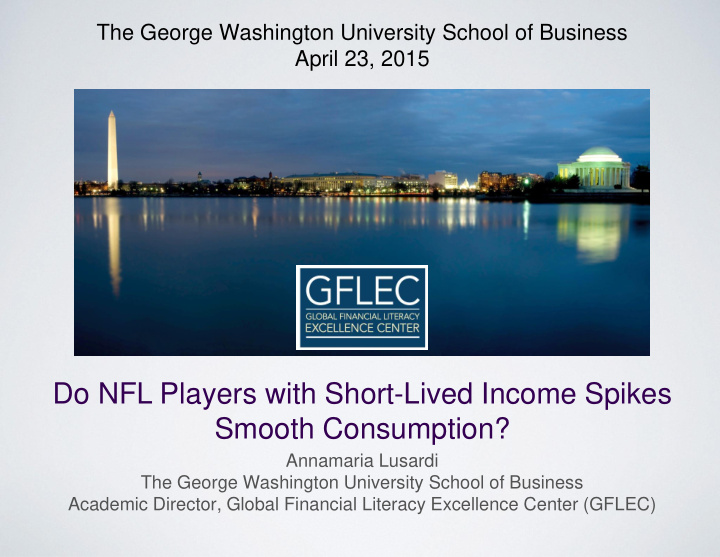



The George Washington University School of Business April 23, 2015 Do NFL Players with Short-Lived Income Spikes Smooth Consumption? Annamaria Lusardi The George Washington University School of Business Academic Director, Global Financial Literacy Excellence Center (GFLEC)
Joint work with many collaborators — Colin Camerer – Professor of Behavioral Economics and Neuroscience at Caltech – Winner of “genius” prize from MacArthur Foundation — Kyle Carlson Graduate student at Caltech — Joshua Kim Student at the University of Washington
Test of a fundamental economic model Life cycle model of saving Used by all financial planners and what we recommend people do for retirement saving Main idea People should save when income is high to provide for when income is low, for example, after retirement The tale of the ant and the grasshopper But is this how people behave?
Study a special group: NFL players National Football League (NFL) players — Income spike: Huge, short-lived, and risky — Median career earnings: $3.2 million (Y2000 dollars) — Enough earnings for a lifetime of consumption — Sudden income change: Predictable, almost unavoidable — Young, inexperienced, highly visible, subject to social influences
Big data collection effort Data — Sample: All drafted players, 1996-2003 (N = 2,016) — NFL careers: pro-football-reference.com, NFL.com — NFL income: spotrac.com, usatoday.com — NFL financial: Commercial background check services (bankruptcy filing is public record.) — Coverage: 1996-2013
Example income profile
Post-NFL income “Retirement” means not playing in the NFL. Players may get new jobs... — Takes some time to find a new job — Becoming a post-NFL “star” is pretty rare => Much lower income The “income spike” argument holds as long as players do not become stars immediately after retiring.
Our empirical strategy We do not have data on saving or consumption: Look instead at bankruptcy filings Bankruptcy filings (BKs): Indicator of low net worth and financial fragility Estimate BK hazard rate during retirement
Our findings Preview of our findings Result: BKs start soon after retirement Result: BK hazard is insensitive to career earnings Result: BK hazard is similar to (if not higher than) the general population of young (college educated) people Different statistics than reported in sports magazines, like Sports Illustrated
Earnings: Little protective effect early in retirement 0.0003
Comparison to National Longitudinal Survey of Youth (NLSY97)
Comparison to NLSY97
Summary NFL players typically earn several million dollars in a few years Bankruptcy starts soon after retirement and is not lower than general population of young people (perhaps higher) Career earnings and career length provides little protection against bankruptcy
Future: New and bigger paper
How much do people know? More than $102 “Suppose you had $100 in a savings 1. Exactly $102 account and the interest rate was 2% per Less than $102 year. After 5 years, how much do you Don’t know think you would have in the account if Refuse to answer you left the money to grow?” “ Imagine that the interest rate on your More than today 2. Exactly the same as today savings account was 1% per year and Less than today inflation was 2% per year. After 1 year, Don`t know with the money in this account, would you be able to buy …” Refuse to answer “ Do you think the following statement is 3. True true or false? Buying a single company False stock usually provides a safer return Don`t know than a stock mutual fund .” Refuse to answer
How much do people know? Evidence from the general population Distribution of responses across the U.S. population Distribution of Responses to Financial Literacy Questions (%) (2009 National Financial Capability Survey) Responses Correct Incorrect DK Refuse Interest rate 65% 21% 13% 1% Inflation 64% 20% 14% 2% Risk diversif. 52% 13% 34% 1% NB: Only 30% correctly answer all 3 questions; less than half (46%) got the first two questions right.
Financial knowledge among the young Financial knowledge by age in the United States – 2012 US National Financial Capability Study (% answering 3 questions correctly) 60% 55% 54% 50% 49% 50% 43% 42% 38% 38% 40% 34% 28% 30% 22% 20% 13% 10% 0% 18-24 25-29 30-34 35-39 40-44 45-49 50-54 55-59 60-64 65-69 70-74 75+
It pays to be financially literate Debt and debt management Investments Planning and wealth accumulation
New personal finance course at GWSB Undergraduates, graduate students, and… athletes Comment at the end of the course: “Everybody needs this course”
Simple planning and calculation Suppose you have accumulated $5 million by the time you retire. At an interest rate of 5%, you can consume $250,000 each year without decreasing your capital
THANK YOU! Carlson / Kim / Camerer / Lusardi
Recommend
More recommend